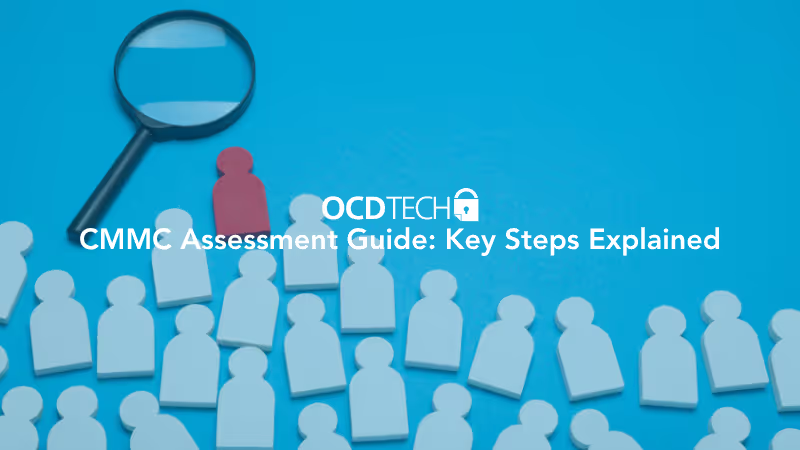By
OCD Tech
•
3
min read

The Cybersecurity Maturity Model Certification (CMMC) is a Department of Defense (DoD) framework designed to ensure that sensitive defense information is properly protected against cyber threats. It establishes five levels of cybersecurity maturity, from basic cyber hygiene (Level 1) to advanced, proactive measures (Level 5), each building upon the previous.
The CMMC framework standardizes cybersecurity expectations across all DoD contractors, ensuring consistent protection of Controlled Unclassified Information (CUI) and Federal Contract Information (FCI). Beyond compliance, the model fosters a culture of cybersecurity accountability, helping organizations strengthen both their internal security and their role in safeguarding national defense data.
Before preparation begins, determine which CMMC level your contracts require.
Accurately identifying your target level helps your organization focus efforts, allocate resources efficiently, and ensure compliance with specific DoD requirements.
Comprehensive documentation is essential to demonstrate compliance. This includes your security policies, risk assessments, incident response plans, and network diagrams. Updated, well-organized documentation allows assessors to verify your cybersecurity maturity and provides a clear picture of your operational security posture.
Regularly review and update documentation to reflect any procedural or technological changes. Continuous maintenance of these materials not only supports CMMC readiness but also strengthens your overall governance and risk management framework.
Performing a gap analysis helps compare your current security posture with CMMC requirements for your desired level. This diagnostic exercise identifies missing or weak controls, creating a roadmap for targeted improvement.
Prioritize remediation based on risk and contract obligations. Understanding where you stand before the formal audit helps streamline preparation and reduces surprises during the assessment phase.
Based on the results of your gap analysis, build a CMMC action plan that clearly defines the steps, responsibilities, and timelines required to close identified gaps. This plan ensures that your organization systematically improves compliance, addresses vulnerabilities, and aligns with the specific practices outlined in the CMMC framework.
Treat your plan as a strategic initiative, not a checklist, integrating milestones, internal accountability, and regular progress reviews to maintain focus and alignment across departments.
Once your organization is ready for certification, you must work with an accredited CMMC Third-Party Assessment Organization (C3PAO). Choose a firm with proven experience in your industry and your target CMMC level.
Coordinate scheduling in advance to minimize disruption, and ensure your team is available during the evaluation. During the assessment, the C3PAO will:
Treat this assessment as both an evaluation and an opportunity to validate your commitment to cybersecurity maturity.
At OCD Tech, our team of certified professionals can guide you through every stage of this process, ensuring your organization is fully prepared for certification and aligned with DoD requirements.
If any deficiencies are found, promptly address them and provide proof of remediation to your assessor. Once all requirements are met, your organization will be granted certification, confirming your cybersecurity maturity level and compliance with DoD standards.
Timely resolution of findings demonstrates accountability and continuous improvement, key values of a strong cybersecurity culture.
CMMC compliance doesn't end with certification. Maintaining your maturity level requires ongoing vigilance:
This proactive approach not only preserves compliance but also ensures that your cybersecurity practices evolve alongside emerging threats, keeping your organization resilient and audit-ready.

Audit. Security. Assurance.
IT Audit | Cybersecurity | IT Assurance | IT Security Consultants – OCD Tech is a technology consulting firm serving the IT security and consulting needs of businesses in Boston (MA), Braintree (MA) and across New England. We primarily serve Fortune 500 companies including auto dealers, financial institutions, higher education, government contractors, and not-for-profit organizations with SOC 2 reporting, CMMC readiness, IT Security Audits, Penetration Testing and Vulnerability Assessments. We also provide dark web monitoring, DFARS compliance, and IT general controls review.
Contact Info
.svg)
OCD Tech
.svg)
25 BHOP, Suite 407, Braintree MA, 02184
.svg)
844-623-8324
.svg)
https://ocd-tech.com
Follow Us
Videos
Check Out the Latest Videos From OCD Tech!
Services
SOC Reporting Services
– SOC 2 ® Readiness Assessment
– SOC 2 ®
– SOC 3 ®
– SOC for Cybersecurity ®
IT Advisory Services
– IT Vulnerability Assessment
– Penetration Testing
– Privileged Access Management
– Social Engineering
– WISP
– General IT Controls Review
IT Government Compliance Services
– CMMC
– DFARS Compliance
– FTC Safeguards vCISO